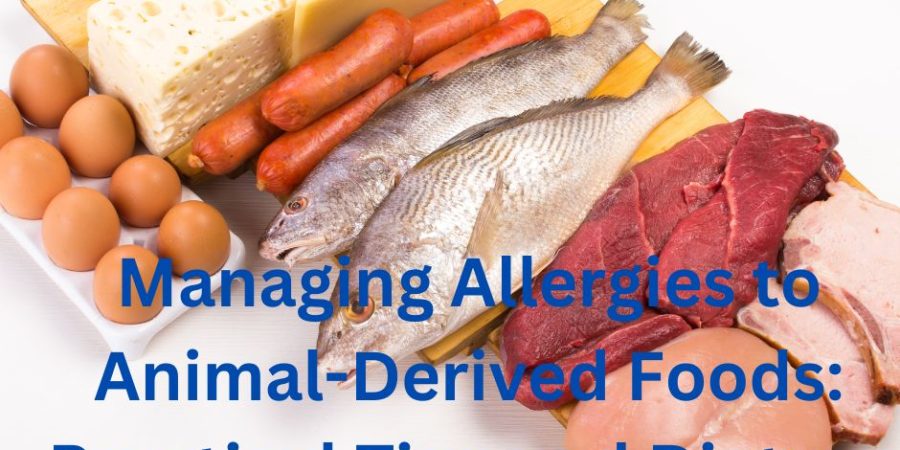
Allergies to animal-derived foods can be challenging to manage, especially when ingredients like eggs, dairy, and seafood are prevalent in many diets. From reading ingredient labels to choosing safe substitutes, here’s a guide to living well with these food allergies.
1. Identify Common Animal-Derived Allergens
Allergies to animal products typically involve reactions to proteins found in foods like:
- Dairy (milk, cheese, yogurt)
- Eggs (including products with egg-derived ingredients like albumin or lysozyme)
- Seafood and Shellfish
- Meat and Poultry (including specific allergies to certain types of meat, like beef or pork)
- Gelatin and Animal-Derived Additives (such as casein, whey, or animal-based enzymes)
Take a test from this approved lab click here
2. Read Labels Carefully
Ingredient labels are critical in managing allergies. Food labeling laws require companies to list common allergens, but animal-derived ingredients are sometimes hidden under scientific names or ambiguous terms. Here are a few tips:
- Look for hidden dairy: Ingredients like whey, casein, and lactose are derived from milk.
- Egg derivatives: Albumin, globulin, and lecithin (often from eggs) are commonly found in baked goods.
- Shellfish and seafood: Sometimes used in sauces and broths; look out for terms like “anchovy” or “fish sauce.”
- Gelatin and animal enzymes: Used in many candies, marshmallows, and even some yogurts.
Apps like Content Checked or Sift can help scan ingredient lists for hidden animal-derived allergens.
3. Choose Plant-Based Alternatives
With the growing popularity of plant-based diets, there are many alternatives to animal-derived foods that can easily fit into your diet:
- Dairy Alternatives: Try plant-based milks like almond, soy, oat, or coconut milk. For dairy-free cheese, brands like Daiya and Miyoko’s Creamery offer options made from nuts and tapioca.
- Egg Replacements: Substitute eggs with applesauce, mashed bananas, or chia/flaxseeds in baking. Products like JUST Egg or Ener-G Egg Replacer are convenient for cooking without eggs.
- Meat and Seafood Substitutes: Many companies now make plant-based meat alternatives, like Beyond Meat and Impossible Foods. For seafood alternatives, try options like Good Catch (for plant-based tuna) or Sophie’s Kitchen.
4. Dining Out: How to Stay Safe
Eating out can be one of the biggest challenges for those with food allergies. Here’s how to prepare:
- Call Ahead: Inform the restaurant about your allergies before you go to ensure they can accommodate you.
- Use Allergen Cards: Many people find it helpful to bring a small allergen card explaining their allergy, which they can hand to restaurant staff.
- Stick to Known Cuisines: Some cuisines are less reliant on animal-derived ingredients. For example, many Mediterranean and Asian dishes are dairy-free, while vegan and vegetarian restaurants often use plant-based ingredients exclusively.
5. Watch for Cross-Contamination
Cross-contamination can occur if a safe food comes into contact with an allergen, which is particularly risky with animal-derived foods:
- Home Kitchen Practices: Use separate cooking utensils, cutting boards, and pans for allergen-free meals. Consider setting aside allergy-safe prep areas and storage.
- Allergy Alerts in Restaurants: Ensure your server knows to inform the kitchen of any allergy concerns. Some restaurants have allergy-friendly kitchens or use allergen-free prep stations.
6. Stay Prepared with an Emergency Plan
In case of accidental exposure, having a plan in place can make a huge difference:
- Epinephrine Auto-Injector: If prescribed, always carry an epinephrine auto-injector (e.g., EpiPen) for severe allergic reactions.
- Medical Alert Bracelet: Wearing a medical alert bracelet can be helpful in emergencies, ensuring that responders are aware of your allergies.
- Educate Friends and Family: Make sure those close to you are familiar with your allergies, symptoms of anaphylaxis, and how to assist if needed.
7. Embrace Support and Resources
- Join Support Groups: Online communities like Food Allergy Research & Education (FARE) provide resources, recipes, and community support.
- Allergy-Friendly Products: Many brands now specialize in allergen-free foods, including Enjoy Life (for allergen-free snacks) and Free2b (for dairy and nut-free treats).
Final Thoughts
Living with allergies to animal-derived foods requires vigilance and preparation, but with the growing availability of plant-based alternatives, it’s easier than ever to maintain a safe, satisfying diet. By being proactive, reading labels, and finding safe alternatives, you can still enjoy diverse, delicious meals while staying healthy and allergy-free.


Leave a Reply